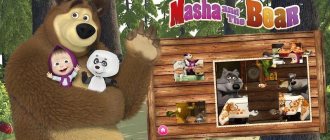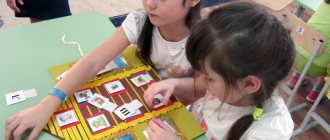Life safety games in a preschool educational institution
"If a stranger knocks on the door"
Game training
Goal.
- Teach children to open the door when they are alone at home, only to people living in the same apartment with them.
Progress of the training
The teacher and children play out situations in which a child, being alone in the apartment, should not allow strangers into the house. One of the children stands outside the door, the rest persuade him to open the door, using attractive promises, affectionate words and intonations
Example situations:
— the postman brought an urgent telegram; — a mechanic came to repair the crane; — a policeman came to check the alarm; — the nurse brought medicine for grandma; - Mom’s friend came to visit; — neighbors ask for greenery for an injured child; — strangers ask to leave things for neighbors; — the woman needs to call an ambulance. The training is repeated several times with different participants.
“Where to run if you are being chased”
Goal.
- Teach children different ways to respond to a threatening situation.
Material.
Pictures depicting a park, a deserted road, a stop with people waiting for a bus, a traffic police post.
Progress of the lesson
Children look at the pictures, express and justify their opinion about where to run from their pursuers.
“Swimming in the sea” Purpose.
- Prevent children from accidents while swimming in the sea or river.
Material.
Toys (laid out on the floor) - for each pair of children. Musical arrangement. Audio recording “The Sound of the Sea”.
Progress of the lesson
Before “entering the water,” children perform several gymnastic exercises. “Having entered the water,” they are divided into pairs (one plays the role of an adult, the other a child) and join hands. The “child” closes his mouth, eyes, and lowers his face into imaginary water. After a pause, he raises his face. The teacher reminds you that you can only lower your face into the water by closing your mouth. Then the “child” performs the following exercises: squats (“goes headlong under water”), counts to himself to 5, stands up; takes out a toy from the “bottom”; blows on the “water”; makes a quick exhalation under the “water”. Children in pairs change roles.
“Put the edible fungus in the box”
Purpose.
- To consolidate children's knowledge about edible and inedible mushrooms.
Material.
A set of pictures depicting edible and inedible mushrooms (or dummies). Trees (or toys) cut out of cardboard. Basket.
Progress of the game
Pictures with mushrooms (dummies) are laid out under the “trees”. Children collect only “edible mushrooms” in the basket. At the end of the game, the teacher takes out all the mushrooms from the basket one by one, and the children name them.
"The Snow Queen"
Goal.
- Help your child see positive character traits in every person.
Progress of the game
The teacher asks you to remember the fairy tale by G.-H. Andersen's "The Snow Queen".
Children say that in this fairy tale there was a mirror, reflected in which everything good and beautiful turned into bad and ugly. How much trouble the fragments of this mirror caused when they got into people’s eyes!
The teacher says that this fairy tale has a continuation: when Kai and Gerda grew up, they made magic glasses through which, unlike a mirror, you can see the good that is in every person. He suggests “trying on these glasses”: imagine that they are on, look carefully at your comrades, try to see as much good as possible in everyone and talk about it. The teacher is the first to “put on glasses” and give a sample description of two or three children.
After the game, the children try to tell what difficulties they experienced in the role of observers, what they felt.
The game can be played several times, noting during subsequent discussions that each time we managed to see more good things.
Option.
You can invite the whole group to “put on glasses” and take turns looking at each participant in the game.
“Guess who it is”
Goal.
- Learn to mentally reproduce images of your friends and describe their individual characteristics.
Progress of the game
The teacher chooses one child - the storyteller. The rest sit on chairs forming a circle. The narrator describes one of the children: appearance, clothing, character, inclination towards certain activities, etc. Children guess who we are talking about. The one who guessed first brings the “guessing” child into the circle, and together with the storyteller, holding hands, they walk to the song sung by all the children:
Intellectual game “Child Safety in Nature” for the older children of the kindergarten group
Kalinina Nadezhda Vladimirovna, teacher at MBDOU "Kindergarten No. 2", the city of Okhansk, Perm Territory. Intellectual game “What? Where? When?" on safe behavior of children in nature. (Senior preschool age.)
Goal: consolidation of knowledge on safe behavior in nature.
Objectives: 1. To consolidate knowledge about correct behavior in nature during a thunderstorm, when meeting wild animals and insects. 2. Expand knowledge about edible and inedible mushrooms and poisonous plants. 3. Develop children's speech. 4. Consolidate knowledge about the benefits and harms of fire.
Necessary equipment and materials: images of fairy-tale characters (Baba Yaga, Karabas Barabas, Vupsen and Pupsen, the Snow Queen, Dyudyuka, Mrs. Belodonna), images of various herbs, berries, mushrooms, dangerous situations in nature, images of insects, a black box, a rotating disk with arrow, multimedia equipment, box of matches.
Children sit at a table with a disk with an arrow on it. Around the disk are envelopes with tasks from fairy-tale characters. During rotation, the arrow points to the target.
Progress: Educator: Guys, our kindergarten received a letter from fairy-tale characters. They want to test your knowledge of safe behavior in nature. They are confident that you know nothing and they will easily win this competition against you. Do you want to win against them? (Yes.) Then rotate the arrow and select the first task.
Assignments in envelopes.
1. Baba Yaga is playing against you (on the screen there is an image of Baba Yaga under a tall lonely tree during a thunderstorm). Assignment: Guys, please tell me what I did wrong and advise me on how to do the right thing. (During a thunderstorm, you should not stand under a tree, run, talk on the phone, or hold a metal object in your hand).
2. Vupsen and Pupsen are playing against you. (Give the children pictures with different berries and herbs.) Assignment: Guys, we really love to chew grass and berries, but some of them give us stomach ache, look at the pictures - this is what we recently ate, which could make our stomachs ache and what should we do if we don’t know the edible herb or berry in front of us. (Crow’s eye)
3. The Snow Queen is playing against you. Assignment: look at the picture and say what rule of safe behavior is shown here. (When encountering wild animals, you must be quiet and carefully move away from him).
4. Black box. Dyudyuka is playing against you. She hid an object in this box and wants you to guess what is there. Assignment: There is an object hidden in the box that will help you in the forest, but on the other hand, this object can cause great trouble. Hint - riddle: This is a cramped, cramped house: A hundred sisters are huddled in it. And any of the sisters can flare up like a fire! Don’t joke with your Thin sisters... What item did Dyudyuka wish for? (Matches). How can matches help in the forest? (you can light a fire to cook food and keep warm, fire scares away wild animals). What harm can a fire cause in a forest? (if you do not put out the fire, a fire may start in the forest and all the animals may be left homeless or die). 5. Karabas Barabas is playing against you (images of mushrooms are placed in a basket). Assignment: Guys, I am a very harmful person and therefore I am giving you the most insidious task. I collected all the mushrooms that came my way in the forest. I want you to choose only edible mushrooms from the basket. Let's check if you have chosen the right mushrooms, look at the screen. (The correct answer appears on the screen.) Who can name these mushrooms? (Boletus, boletus, boletus, boletus, russula, boletus). Why are boletus and boletus called so? (Because they grow under birch and aspen).
6. Mrs. Belodonna is playing against you. Assignment: look at the pictures, what insects do you know? Which of them can be dangerous to humans? What rules for safe communication with these insects do you know? (Do not wave your hands in front of a wasp or bee, do not disturb or destroy their nests, use insect repellents). And now to sum up. You guys completed all the tasks and become winners in our competition. Which task was the most difficult for you to complete? Which task did you like the most?








